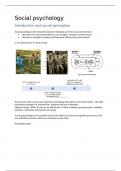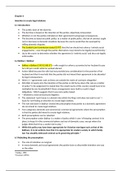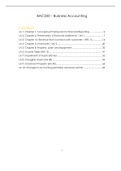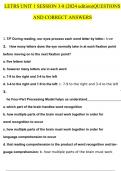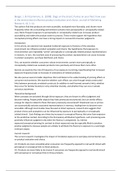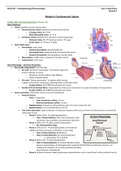1. Evolutionary explanation – Stearns Chapter 1.
Life histories lie at the heart of biology; no other field brings you closer to the underlying simplicities
that unite and explain the diversity of living things and the complexities of their life cycles. Life
history are also the keys to understanding related field. Life history theory is needed to understand
the action of natural selection, a central element of evolution, the only theory that makes sense of all
of biology. Also helps to understand how the other elements, genetic variation, will be expressed.
The evolution of life history traits and their plasticities determines the population dynamic of
interacting species.
Genotypic and phenotypic conditions are necessary for natural selection to occur.
1. Heritable variability: if there will be a response to selection
2. Individual must vary in fitness. Variation = natural selection.
Life history theory predicts the phenotype at equilibrium; population genetics tells us how fast it
should get to that equilibrium – and whether it will get there at all, given genetic constraints
(selection, mutation, drift, gene flow, non-random mating). Demographic traits: birth, age and size at
maturity, number and size of offspring, growth and reproductive investment, length of life, death ->
are connected by constraining relationships, trade-offs.
Principle life history traits: size at birth, growth pattern, age at maturity, size at maturity, number size
and sex ratio of offspring, age and size specific reproductive investments, age and size specific
mortality schedules and length of life. Those are linked with trade-offs: current reproduction and
survival, current reproduction and future reproduction and number size and sex of offspring.
Abstraction of demographic analyses:
1. Robins are monogamous and both parents feed nestlings.
2. Any activities takes time, and activities that reduce the time that can be devoted to
reproduction and survival decreases fitness.
3. The internal constraints on the robin are not evident. A robin can’t lay eggs as large as itself.
4. Raising 15 or 10 chicks -> are they able to survive to reproduce in their third summer?
5. Abstraction itself -> complexity of robin’s life has been reduced to a few elements.
Framework of four elements to explain life history variation:
1. Demography (natural selection)
a. Mortality and fecundity vary with age and size. Demography connects age- and size-
specific variations in mortality and fecundity to variation in fitness.
2. Quantitative genetics and reaction norms (response to selection)
a. Life history traits are influenced by many genes of small effects. Estimated through
correlations between relatives and through the response of a population to
selection.
3. Trade-offs
a. Trade-off exists when a benefit realized through a change in one trait is linked to a
cost paid out through a change in another.
4. Lineage-specific effect.
a. Comparison among higher taxa raise striking questions. Do organisms the delay
maturity live longer?
For example: an underfed woman get her menstruation much later than a fully fed woman. An
underfed or athletic woman also differ in hormone levels -> so no offspring. Age and size at maturity
from positive to zero across a gradient of nutritional conditions.
, Evolutionary causation flows in two directions: from variation in the genes through gene expression
in development, morphology and physiology to the phenotype to changes in gene frequencies.
Traits are not inherited, genes are. Traits don’t survive and reproduce, organisms do. Fitness is a
composite, relative measure of birth and death rates. “r” (intrinsic rate of natural increase) ignores
many aspects of empirical fitness. An adaption is a change to a specific environmental signal and has
a clear functional relationship to that signal that results in an improvement in growth, survival, or
reproduction.
Adaption and constraint interact with each other in the causation of every pattern and in the
determination of every stat of every trait.
2. Life-History Variation – Begon Chapter 14
An organisms life-history is its lifetime pattern of growth, differentiation, storage and, especially
reproduction. Rules when particular traits might be favoured work within constraints: the possession
of one life-history trait may limit the possible range of some other trait, and the general morphology
of an organism may limit the possible range of all its life-history traits. There is plasticity in any life-
history determined by the way in which the genotype of the organism interacts with its environment.
i: number of seeds (genotypic), ii: number is reduced during drought (plasticity) and iii: seed number
is reduced by drought itself under genotypic control (some reduce amount, some reduce size).
Size
Most apparent aspect of an organism’s life-history. Larger animals produce more offspring, but
increase risks. A larger tree is more likely to be felled in a gale or stuck by lightning. They also require
more energy for maintenance, growth and reproduction (can lead to shortage of food). High growth
rate leads to reproduction, short generation lengths.
Rates of growth and development
Arrested development (dormancy and diapause) may be beneficial if the organism passes through a
highly unfavourable period during its lifetime.
Reproduction
Precocity and delay, itero- and semelparity, clutch size clutch number and offspring size,
reproductive allocation: often measured imperfectly.
The uses of soma
Parental care, longevity, dispersal, storage, resource capture and protection.
Reproductive value = contemporary reproductive output + residual reproductive value.
Life-history compromise: Common sense alone suggest that a real organism’s life style and life-
history must be a compromise allocation of the resources that are available to it.
Trade-offs are benefits from one process that are bought at the expense of another. Each aspect of
the life-history that might be expected to increase reproductive value is offset by an associated
change that tends to reduce reproductive value. Trade-offs tend to generate negative correlations:
more migration associated with less reproduction; more reproduction associated with less growth;
and so on. But quite often a positive correlation: the grasshopper is big and thus develop rapidly and
grow large because the consume large amounts of food.
Cost of reproduction: when increasing its current allocation to reproduction, is likely to decrease its
survivorship and/or its rate of growth and therefore decrease its potential for reproduction in future.
Thus individuals that delay reproduction or restrain their reproduction to a level less than the
maximum may grow faster, grow larger and have an increased quantity of resources availability for
maintenance and storage. Natural selection favors the life-history for which the sum of
Life histories lie at the heart of biology; no other field brings you closer to the underlying simplicities
that unite and explain the diversity of living things and the complexities of their life cycles. Life
history are also the keys to understanding related field. Life history theory is needed to understand
the action of natural selection, a central element of evolution, the only theory that makes sense of all
of biology. Also helps to understand how the other elements, genetic variation, will be expressed.
The evolution of life history traits and their plasticities determines the population dynamic of
interacting species.
Genotypic and phenotypic conditions are necessary for natural selection to occur.
1. Heritable variability: if there will be a response to selection
2. Individual must vary in fitness. Variation = natural selection.
Life history theory predicts the phenotype at equilibrium; population genetics tells us how fast it
should get to that equilibrium – and whether it will get there at all, given genetic constraints
(selection, mutation, drift, gene flow, non-random mating). Demographic traits: birth, age and size at
maturity, number and size of offspring, growth and reproductive investment, length of life, death ->
are connected by constraining relationships, trade-offs.
Principle life history traits: size at birth, growth pattern, age at maturity, size at maturity, number size
and sex ratio of offspring, age and size specific reproductive investments, age and size specific
mortality schedules and length of life. Those are linked with trade-offs: current reproduction and
survival, current reproduction and future reproduction and number size and sex of offspring.
Abstraction of demographic analyses:
1. Robins are monogamous and both parents feed nestlings.
2. Any activities takes time, and activities that reduce the time that can be devoted to
reproduction and survival decreases fitness.
3. The internal constraints on the robin are not evident. A robin can’t lay eggs as large as itself.
4. Raising 15 or 10 chicks -> are they able to survive to reproduce in their third summer?
5. Abstraction itself -> complexity of robin’s life has been reduced to a few elements.
Framework of four elements to explain life history variation:
1. Demography (natural selection)
a. Mortality and fecundity vary with age and size. Demography connects age- and size-
specific variations in mortality and fecundity to variation in fitness.
2. Quantitative genetics and reaction norms (response to selection)
a. Life history traits are influenced by many genes of small effects. Estimated through
correlations between relatives and through the response of a population to
selection.
3. Trade-offs
a. Trade-off exists when a benefit realized through a change in one trait is linked to a
cost paid out through a change in another.
4. Lineage-specific effect.
a. Comparison among higher taxa raise striking questions. Do organisms the delay
maturity live longer?
For example: an underfed woman get her menstruation much later than a fully fed woman. An
underfed or athletic woman also differ in hormone levels -> so no offspring. Age and size at maturity
from positive to zero across a gradient of nutritional conditions.
, Evolutionary causation flows in two directions: from variation in the genes through gene expression
in development, morphology and physiology to the phenotype to changes in gene frequencies.
Traits are not inherited, genes are. Traits don’t survive and reproduce, organisms do. Fitness is a
composite, relative measure of birth and death rates. “r” (intrinsic rate of natural increase) ignores
many aspects of empirical fitness. An adaption is a change to a specific environmental signal and has
a clear functional relationship to that signal that results in an improvement in growth, survival, or
reproduction.
Adaption and constraint interact with each other in the causation of every pattern and in the
determination of every stat of every trait.
2. Life-History Variation – Begon Chapter 14
An organisms life-history is its lifetime pattern of growth, differentiation, storage and, especially
reproduction. Rules when particular traits might be favoured work within constraints: the possession
of one life-history trait may limit the possible range of some other trait, and the general morphology
of an organism may limit the possible range of all its life-history traits. There is plasticity in any life-
history determined by the way in which the genotype of the organism interacts with its environment.
i: number of seeds (genotypic), ii: number is reduced during drought (plasticity) and iii: seed number
is reduced by drought itself under genotypic control (some reduce amount, some reduce size).
Size
Most apparent aspect of an organism’s life-history. Larger animals produce more offspring, but
increase risks. A larger tree is more likely to be felled in a gale or stuck by lightning. They also require
more energy for maintenance, growth and reproduction (can lead to shortage of food). High growth
rate leads to reproduction, short generation lengths.
Rates of growth and development
Arrested development (dormancy and diapause) may be beneficial if the organism passes through a
highly unfavourable period during its lifetime.
Reproduction
Precocity and delay, itero- and semelparity, clutch size clutch number and offspring size,
reproductive allocation: often measured imperfectly.
The uses of soma
Parental care, longevity, dispersal, storage, resource capture and protection.
Reproductive value = contemporary reproductive output + residual reproductive value.
Life-history compromise: Common sense alone suggest that a real organism’s life style and life-
history must be a compromise allocation of the resources that are available to it.
Trade-offs are benefits from one process that are bought at the expense of another. Each aspect of
the life-history that might be expected to increase reproductive value is offset by an associated
change that tends to reduce reproductive value. Trade-offs tend to generate negative correlations:
more migration associated with less reproduction; more reproduction associated with less growth;
and so on. But quite often a positive correlation: the grasshopper is big and thus develop rapidly and
grow large because the consume large amounts of food.
Cost of reproduction: when increasing its current allocation to reproduction, is likely to decrease its
survivorship and/or its rate of growth and therefore decrease its potential for reproduction in future.
Thus individuals that delay reproduction or restrain their reproduction to a level less than the
maximum may grow faster, grow larger and have an increased quantity of resources availability for
maintenance and storage. Natural selection favors the life-history for which the sum of


